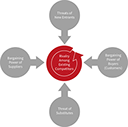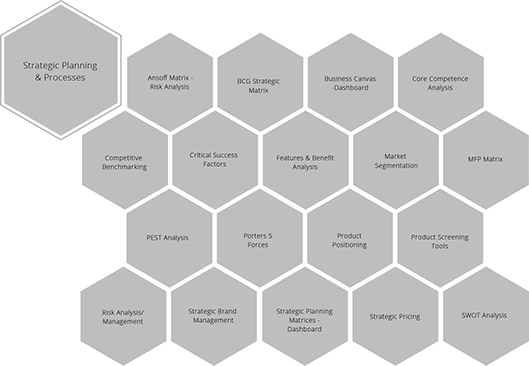Glossary
Logout
©Copyright Arcturus 2022, All Rights Reserved.
7
Terms & Conditions
|
|
|
|
Security & Privacy
Contact
PORTERS 5 FORCES ANALYSIS
|Introduction
Porters 5 Forces Analysis is a strategic planning tool originally designed/created by Harvard Business School professor Michael Porter, to analyse an industry's attractiveness and likely profitability of a business within that environment. Since its publication in 1979, it has become one of the most popular and highly regarded business strategy tools.
Porter recognised that organisations likely keep a close watch on their rivals, but he encouraged them to look beyond the actions of their competitors and examine what other factors could impact the business environment. He identified five forces that make up the competitive environment, and which can erode your profitability. These are as follows:
|Bargaining Power of Suppliers
An assessment as to how easy it is for suppliers to drive up prices.
This is driven by the number of suppliers of each key aspect / component, the uniqueness of their product or service, their strength and control over you, the cost of switching from one to another, and so on.
The fewer the supplier choices you have, and the more you need suppliers' helo, the more powerful your suppliers are.
A supplier that owns raw material (or single source) is a potential threat to the business and must be considered as such.
Bargaining power of Suppliers;
- Buyer propensity to substitute
- Relative price performance of substitute
- Buyer switching costs
- Perceived level of product differentiation
- Number of substitute products available in the market
- Ease of substitution
- Substandard product
- Quality depreciation
- Availability of close substitute

|Threat of New Entrants
This is the force of Competitors (or New Competitors) to enter the market. In the final analysis if the investment of time or money to enter your market and there are few economies of scale in place, or if you have little protection for your key technologies, then new competitors can quickly enter your market and weaken your position.
If you have strong and durable barriers to entry, then you can preserve a favourable position and take advantage of that position.
This analysis highlights the importance of differentiation (product / market) and is therefore considered a key success factor.
Threat of Entrants :
The existence of barriers to entry (patents, rights, etc.). The most attractive segment is one in which entry barriers are high and exit barriers are low. Few new businesses can enter and non-performing firms can exit easily.
- Government policy
- Capital investment requirements
- Absolute costs
- Cost disadvantages independent of size
- Economies of scale
- Economies of product differences
- Product differentiation
- Brand equity
- Switching costs or sunk costs
- Expected retaliation
- Access to distribution
- Customer loyalty to established brands Industry profitability (the more profitable the industry the more attractive it will be to new competitors)

|Bargaining Power of Buyers (Customers)
How easy it is for buyers (Customers) to drive prices down.
This is primarily driven by the number of buyers within , the importance of each individual buyer to your business, the cost to them of switching from your products and services to those of someone else, and so on.
It is somewhat typical that if you deal with few, powerful buyers, then they are often able to dictate terms to you.
(e.g. government contracts, etc.)
Buyer Power
- Buyer concentration to firm concentration ratio
- Degree of dependency upon existing channels of distribution
- Bargaining leverage, particularly in industries with high fixed costs
- Buyer switching costs relative to firm switching costs
- Buyer information availability
- Force down prices
- Availability of existing substitute products
- Buyer price sensitivity
- Differential advantage (uniqueness) of industry products
- RFM (customer value) Analysis
- The total amount of trading

|Threat of Substitutes
This is the direct or indirect ability of your customers to find a different way of satisfying their needs.
If substitution (alternative solution) is easy and the substitution is viable, then this weakens your commercial position.
Places to look for; Substitution aspects:
- Buyer propensity to substitute
- Relative price performance of substitute
- Buyer switching costs
- Perceived level of product differentiation
- Number of substitute products available in the market
- Ease of substitution
- Substandard product
- Quality depreciation
- Availability of close substitute

|Rivalry Among Existing Competitors
We need to understand the number and capability (robustness of your competitors).
If there are many competitors, and they offer equally attractive products and services, then you'll most likely have little power in the situation, because suppliers and buyers may potentially go elsewhere for a better deal.
If you are serving the market with a unique proposition this will translates to a point of commercial strength.
Places to look for; Competitors aspects.
- Sustainable competitive advantage through innovation
- Competition between online and offline companies
- Level of advertising expense
- Powerful competitive strategy
- Firm concentration ratio
- Degree of transparency

|Related Procedures
The following interrelationship maps indicate; suggested content from other models/processes which may have influence or an effect on the analysis of the title process. The left-hand column indicates information or impact from the named process and the left-hand column indicates on completion of the process/analysis it may have an influence or effect on the listed processes.
Note: A complete set (professional quality) of PMM interrelationship cards are available to purchase - please contact us for further details.

|Who Should Attend...
Key / Definition:
Monitor: Oversees the overall process, required to provide top level strategic objectives as required, performs a management role.
Core: Defines the ‘Core’ team headed (chaired) by the Product Manager required to attend the workshop in alignment with the ‘Product Phase’. Membership is mandatory.
Sec. Mem: Secondary Membership defines an ‘on‐standby’ membership requirement and will depend upon the subject area, phase alignment and the project status. Membership is managed by the Product Manager.
On Req: On Request membership defines a membership that is managed by the Product Manager.
|Strategic Business Models, Workshop Tools & Professional Resources
The IPM practitioner series, is a definitive and integrated training programme for management professionals operating in the Product Management arena. So whether you’re the Managing Director, Product Director, Product Manager or a member of the Multidisciplinary Team we are confident that you will find this particular training series to be one of the best available and an invaluable asset to both you and your company.
PMM - Professional Support
Interactive Business Models
More






























